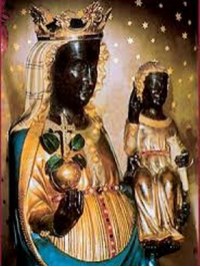Storia Santuario della Madonna d'Oropa

Il Santuario di Oropa è il santuario mariano più grande dell’arco alpino
Col predominio, nel II secolo a.c. i romani occupano la pianura e le genti "Celti-Liguri" sono costretti a ritirarsi nelle valli montane tra le quali Oropa, portando con sé il culto religioso delle "Matronae o Matres", onorate come protettrici dei campi, della natura e delle famiglie.
Radunavano la gente presso fonti, torrenti, boschi, grandi massi, ritenuti luoghi di presenza delle Matres, divinità femminili.
Unisciti a noi
Da San Eusebio ad oggi
Col predominio, nel II secolo a.c. i romani occupano la pianura e le genti "Celti-Liguri" sono costretti a ritirarsi nelle valli montane tra le quali Oropa, portando con sé il culto religioso delle "Matronae o Matres", onorate come protettrici dei campi, della natura e delle famiglie.
Radunavano la gente presso fonti, torrenti, boschi, grandi massi, ritenuti luoghi di presenza delle Matres, divinità femminili.
Oropa, infatti, con la sua conca è un classico cerchio celtico di pietre, dove la "barma", cioè la caverna formata da massi costituisce un menhir naturale. E in questa grotta formata da massi e sacra alle matrone celtiche, nel secolo IV d.C. San Eusebio introdusse il culto di Maria portandovi una statua lignea della madonna nera con il bambino in braccio, che la tradizione vuole scolpita da San Luca.
Qualche tempo dopo Eusebio costruisce più a sud e al riparo di un'altra "barma" il Sacello come luogo più conveniente per il culto.
Il Papa Innocenzo III nella Bolla del 1207, parla dell'oratorio di "Santa Maria d'Oropa" e di San Bartolomeo nei quali, alcuni eremiti, celebravano uffici divini.
Nel 1294 il Vescovo di Vercelli, Aimone di Challant sale ad Oropa per consacrare una seconda Chiesa "Di Santa Maria" più ampia per la venerazione alla Vergine e per la devozione del popolo. E' eretta davanti al Sacello eusebiano.
Questo Vescovo obbliga nel 1298, attraverso il suo testamento, di celebrare a Oropa una messa settimanale in memoria di San Eusebio.
Nel 1536 viene costruita dietro l'altare della Chiesa un corridoio chiamato anti sacello, poi viene aperta una grande finestra protetta da una inferriata per permettere ai devoti la visione della statua della Madonna, anche dalla Chiesa denominata "grande".
In questa epoca la Chiesa di Santa Maria d'Oropa diviene oggetto di provvedimenti pontifici e vescovili, finché nell'anno 1459 viene dal Pontefice Pio II assegnata, coi terreni che le appartenevano, ai Canonici di Santo Stefano di Biella, i quali ne presero e non ne tralasciarono più la cura.
Per la grande affluenza di pellegrini nel 1600 il Vescovo Stefano Ferrero fece costruire una basilica che inglobasse la vecchia chiesa, il Sacello e l'antisacello. Lavori che durarono sino al 1621.
Nel 1620 attorno alla Basilica inizia la costruzione del grande recinto dell'Arduzzi.
Nel 1920 è demolito l'anti sacello e viene inserito al suo posto un basso altare di marmo per permettere la visione della statua della Vergine Maria, da tutta la Basilica. Nel contempo viene restaurato il Sacello con marmi come lo si può osservare oggi, in esso è racchiusa la Sacra Statua che rappresenta Maria Regina con Gesù bambino in braccio.
Giacomo Orsi nel 1488 scriveva: "Ascendendo al sacello della Regina dei cieli, posto sotto le sorgenti dell'Oropa, del quale la prima pietra il santo martire di Dio Eusebio con le proprie mani collocò. In quel luogo la beatissima Vergine rifulge per si grande santità di stupendi miracoli, così non solo dai popoli locali ma anche dai lontani vi confluisce una turba".
Nella lettera pastorale del 1595, Papa Clemente VIII dice di Oropa: "...l'antichissima immagine lignea della Beata Vergine Maria, presso la quale si rifugiò San Eusebio, mentre era Vescovo di Vercelli, fuggendo le persecuzioni ariane.. che tra l'altro fu ritenuta tra le opere di San Luca".
Successivamente e in epoche diverse iniziarono le opere ampliamento del santuario sia dal punto di vista urbanistico, sia architettonico. Parteciparono alla "crescita" del Santuario architetti come Filippo Juvarra, Piero Beltramo, Guarino Guarini e altri ancora, sino a formare una vera città mariana.
Nel 1960, dopo due secoli di progetti e lavori è stata consacrata la Basilica nuova o Superiore. Posata la prima pietra nel 1885, i lavori sono proseguiti attraverso due guerre mondiali. Essa ha una cupola che si eleva oltre 80 metri e può contenere sino tremila fedeli.
